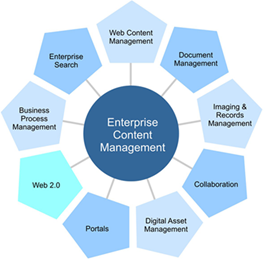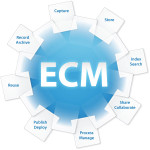6 Challenges of Implementing an Enterprise Content Management System
Organizations, small and large alike, are focusing more and more on Enterprise Content Management initiatives to manage content chaos that pervades local drives, file shares, email systems and document stores. Every ECM initiative comes with its own set of challenges. In the following section we are trying to list down 6 such challenges
In the following section we are trying to list down 6 such challenges
Challenge 1: Vision & Ownership
Any successful ECM implementation is driven by a very early realization of developing an effective strategy and business case. A clear articulation and even more clearer communication of this ECM vision across the enterprise is usually the fundamental difference between the success and failure of this initiative. Every department and key stakeholders within each department need to be onboard on this initiative right from the start. ECM implementation is often considered an IT initiative, because of its heavy focus on technology enablement, and the level of ownership from business is usually low. The real challenge is to make everyone part of this vision and have Business drive it with the help of IT rather than IT driving it for Business.
Challenge 2: Identifying the Right Team
The second and probably the most important challenge implementing an ECM is to identify the right team. Usually, an ECM team comprises of SMEs (subject matter experts) from every department, IT and optionally a third party vendor which specializes in ECM implementations and has enough experience in doing an end-to-end implementation. ECM is a fairly complex domain and requires very specific knowledge of tools and processes to implement it. Expecting your IT to take it through without the help of a vendor can result in lack of direction and this is why many ECM implementations fail to achieve their promises.
Challenge 3: Selecting the Right ECM Framework
Selecting the right framework for ECM implementation is another challenge that needs to be addressed with care. Industry leading tools like Microsoft SharePoint, Documentum, FileNet and Aflresco all provide the necessary framework for mapping business requirements to technical solutions. Usually, it is advisable to use the same set of tools with which users are already familiar. For example, if SharePoint is already being used for basic collaboration within the enterprise then it makes more sense to leverage this ROI and design your ECM implementation over SharePoint. Users of SharePoint may want to utilize a SharePoint analytics tool for site and list auditing.
Challenge 4: Understanding Business Diversity
Every business is unique in the way it operates. Understanding the diversity in your business and its implication is absolutely vital in the success of ECM implementation. This is where identification of the right stakeholders from every department plays a vital part. With the help of these business stakeholders commonalities and differences between how different departments create, process, manage and store their content need to be identified fairly early in the analysis phase.
Challenge 5: Estimation
Estimating the effort required for an end-to-end implementation is a fairly complex task. The trick really is to divide the implementation in different phases. The first phase is usually comprised of doing a pilot implementation on a limited scale where a few departments are selected and an end-to-end implementation is done. It becomes easier to estimate the implementation of remaining departments after a successful pilot rollout. Typical phases for a pilot implementation are
- Inception
- Analysis
- Design
- Implementation
- Training
Challenge 6: Trainings
A successful ECM implementation is about repeating the mantra of Information Management and keeping all the users in the loop of the expected organizational changes to achieve ECM. End user training should be targeted towards understanding the strategies, tools and technologies used to capture, process, manage , store and deliver information in support of their respective business processes. It must be noted that a significant portion of the ECM implementation effort should be spent on training so that users are readily prepared for upcoming changes and adopt the change without any reluctance.





